
Bucharest became the center of European heritage preservation, as over 800 guests, joined by many more viewers online, gathered for the prestigious European Heritage Awards/Europa Nostra Awards ceremony. The event, a highlight of this year’s European Heritage Summit, celebrated 26 remarkable laureates from across Europe. Co-hosted by European Commissioner Iliana Ivanova, the ceremony revealed the winners of the five Grand Prix and the Public Choice Award, chosen from among this year’s honorees. The Grand Prix winners represent exceptional contributions to European heritage across various categories:
1. Ignacy Historic Mine (Rybnik, Poland) – Conservation & Adaptive Reuse This award celebrates the meticulous restoration of one of Poland’s oldest coal mines, founded in 1792. The site, which was operational for over 200 years, now stands as a unique cultural landmark. The renovation has transformed the industrial heritage site into a vibrant space for education, tourism, and community engagement, while preserving the historical significance of Poland’s mining heritage.
2. Saxon Church in Alma Vii (Romania) – Conservation & Adaptive Reuse In the picturesque village of Alma Vii in Transylvania, a centuries-old Saxon church has been restored, not only preserving its architectural and historical integrity but also revitalizing the local community. The restoration project empowered local residents, creating opportunities for sustainable tourism, and renewing a sense of ownership over the region’s cultural treasures.
3. Traditional Farm Buildings Scheme (Ireland) – Education, Training & Skills This innovative scheme was developed to help farmers across Ireland understand the cultural value of traditional farm buildings and equip them with the skills necessary for their restoration. Since its launch in 2008, over 1,000 buildings have been repaired, contributing to the preservation of Ireland’s rural heritage. The program has promoted the sustainable use of historic farm structures, ensuring their continued function in modern agricultural life.
4. Citizens’ Rehabilitation of the Tsiskarauli Tower (Akhieli, Georgia) – Citizens’ Engagement & Awareness-Raising This inspiring project saw 46 Georgian and international volunteers working together with technical experts and traditional craftspeople to restore the Tsiskarauli Tower in Georgia’s Akhieli village. Over a three-year period, the initiative not only rehabilitated a key cultural landmark but also raised awareness of the significance of Georgian heritage within the broader European context. The project has become a symbol of community-led heritage preservation.
5. Society of Friends of Dubrovnik Antiquities (Croatia) – Heritage Champions This civil society organization has been a driving force in the conservation of Dubrovnik’s iconic landmarks, including the City Walls, for over 70 years. The Society played a crucial role in the inclusion of Dubrovnik on the UNESCO World Heritage List in 1979. Their ongoing efforts have ensured that this historic city continues to be safeguarded for future generations, with numerous research and restoration projects supported by the association. With the support of institutions and civil society, these projects offer a glimpse into the ways heritage conservation can inspire, educate, and empower communities, furthering the collective effort to protect and cherish Europe’s invaluable heritage for generations to come.
More Informations
